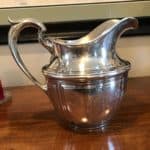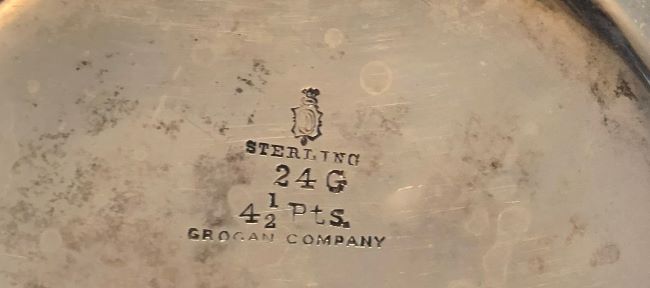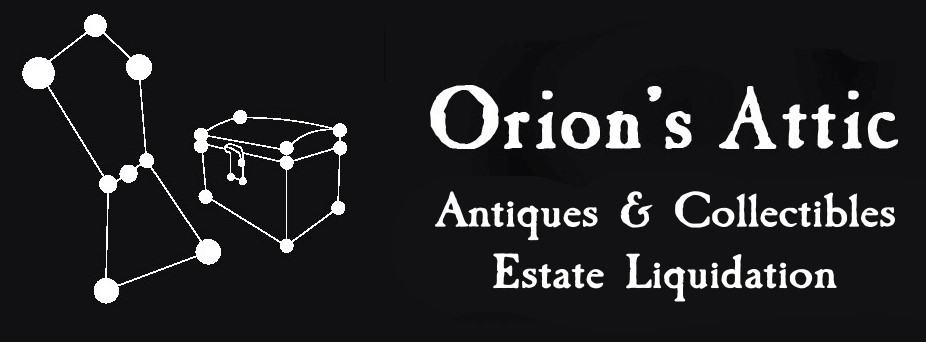
J.C. Grogan sterling silver pitcher
Welcome to our “Ask The Attic” — our new series of posts in which we provide answers to a wide array of questions that people frequently ask us. Today’s question: What’s My Sterling Silver Pitcher Worth?
Figuring out what sterling silver objects are worth can get confusing fast. This J.C. Grogan-marked 4.5 pint pitcher, for example, has several different values. The ultimate and most accurate value comes down to answering a simple question: what do you plan to do with it?
Let’s stipulate that you want to determine your sterling silver pitcher worth from the standpoint of wanting to sell it. What can you realistically get for it?
The unwritten rule in the antiques and collectibles industry – and one that many consumers don’t understand – is that the value of even beautiful pieces of sterling silver is often based on their “melt” or “scrap” value. This is the value that would come from melting a given piece and converting sterling from 92.5 percent silver to pure silver. Silver dealers pay sellers a percentage of that value. Standard online scrap calculators like Silver Recyclers can help you calculate the starting value – the amount you could get if you were able to find someone willing to pay you 100 percent of that value. No one pays that number. Dealers and shops generally offer somewhere between 50 percent to 70 percent of that value, on average.
If you have a sterling silver pitcher that weighs 1 pound, the full value at the time of this writing would be about $207. The average dealer would thus pay between $103.50 to $144.90. Said dealers including us then typically sell the sterling item up the food chain to a refiner. The refiner promptly melts the item so that it can be made into something else. It used to cause me great anguish to think that beautiful, hand-made sterling pitchers, trays and flatware got melted. I now accept reality and take solace in the fact that the silver at least takes on a second life.
Some sterling, particularly antique pieces like this one, can possess a “collector” value – meaning an amount that a buyer with no intention of melting it would pay. Personally, I like pieces retailed by (not necessarily made by) J.C. Grogan. The company dates back to the turn of the 20th century in Pittsburgh, Pennsylvania, where it sold silverware, jewelry, clocks and “fancy goods.” It reported that it had $200,000 in capital in 1906 – an almost shocking number dwarfing many other Pittsburgh companies at the time. That sum is the inflation-adjusted equivalent of more than $5.7 million on today’s money!
The condition here is average by collector standards, and the monogram hurts it a bit. That said, a seller willing to wait long enough may possibly find someone willing to pay up to 20 percent above the full scrap value. Sterling goods by more famous makers like Paul Revere and others can skyrocket past that.
For sellers not eager to try selling sterling silver pitchers like this themselves through eBay (which takes a commission) or other means, it’s often best to sell to a dealer and be done with it. Dealers like us will pay accordingly for pieces with genuine collector value but, more often than not, we’re paying for sterling based on its melt value.
Would you like to sell your sterling silver or do you have questions about your treasures? Contact us today. Orion’s Attic is a full-service estate liquidation company serving Maryland, Washington D.C. and Northern Virginia — and sometimes beyond. We also provide appraisal services.


